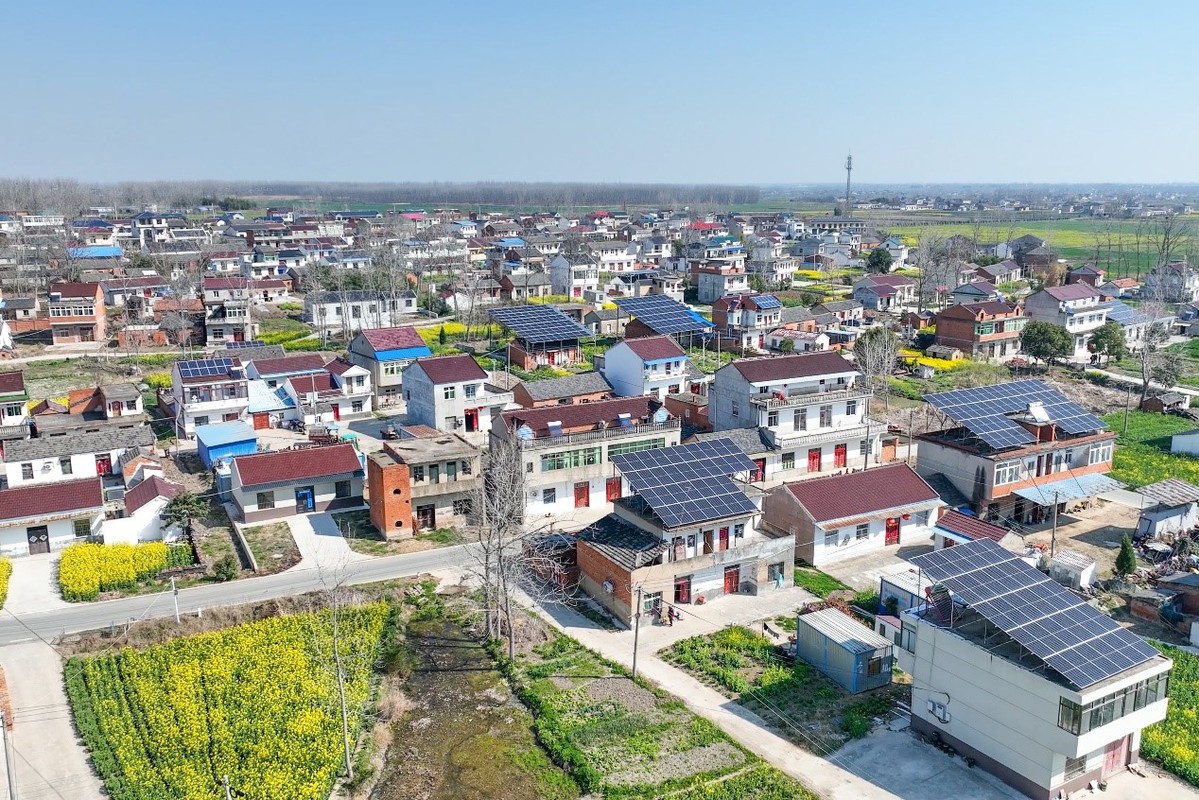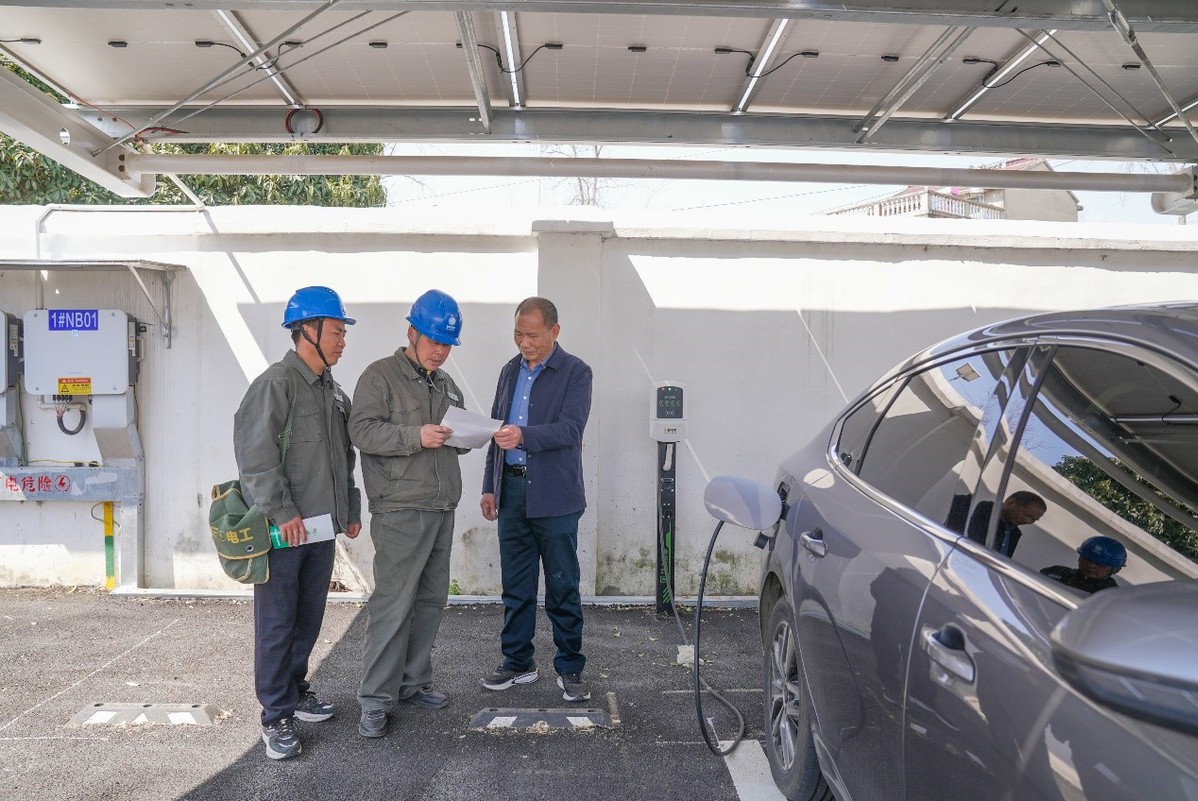
Photo shows some of the photovoltaic panels installed on the rooftops of villagers' homes in Liuqiao community, Feidong county, Hefei, Anhui province. [Photo provided to chinadaily.com.cn]
On March 24, Chen Cheng, a villager from Liuqiao community in Zhangji town, Feidong county, Hefei, Anhui province, was cleaning the photovoltaic panels on his roof. The blue panels shimmered brilliantly under the sun.
Liu Yuanjin, the low-voltage shift leader of the Liangyuan Central Power Supply Station under the State Grid Hefei Power Supply Company, led his colleagues to inspect the equipment in the substation area. They climbed the insulation ladder to check the operation status of the mobile energy storage device, as well as to monitor the battery's charging and discharging load and voltage.
Chendahu village, the largest natural village in the Liuqiao community with over 400 households, has faced challenges in recent years. The construction of rural rooftop photovoltaic power stations connected to the grid has led to an issue where the photovoltaic output period does not align with the load peak. This leads to a significant peak-to-valley difference in the power grid, which affects its stable operation.
Standing outside Chendahu village, one can see photovoltaic panels covering the rooftops of the villagers' homes. "In the past, on sunny days, the voltage in the substation area would rise," said Liu Yuanjin. Since the installation of rooftop photovoltaic panels in the village, the reported installed capacity has increased month by month. Currently, the grid-connected capacity of the Chendahu substation area stands at 320 kilowatts, accounting for 80 percent of the substation's total capacity.
To alleviate the load imbalance in the rural areas, the Hefei Power Supply Company of State Grid is actively exploring smart microgrid networking methods. Taking into account the characteristics of the Chendahu area, such as its large photovoltaic capacity and imbalance between supply and demand, the company has constructed a microgrid system primarily composed of mobile energy storage and intelligent control devices. This system effectively coordinates distributed renewable energy sources like rooftop photovoltaics and automobile charging stations, intelligently manages power storage and consumption, and ensures maximum energy efficiency.
In December 2024, State Grid Hefei Power Supply Company commissioned a mobile energy storage device on the southernmost low-voltage line in Chendahu designated area. This device is capable of providing a 30 kW power load and maintaining peak power supply for 2 hours, ensuring reliable power supply during peak residential electricity consumption period.
For users in the designated area, this "microgrid" system serves as a "power bank". By charging during the day and discharging at night, it helps alleviate some of the excess photovoltaic power generation and provides peak capacity during the evening power consumption peak.
"Now that the village has installed this microgrid system, the electricity supply for villagers has become more reliable, and the photovoltaic income has become more stable than before. Additionally, the village now has a car charging station, which uses photovoltaic power to charge cars, thus saving on charging costs," said Zhang Wei, deputy director of Liuqiao community.

Photo shows employees from the State Grid Hefei Power Supply Company conducting a new energy power safety awareness campaign at a charging station in Liuqiao community of Feidong county. [Photo provided to chinadaily.com.cn]
The commissioning of new power devices has not only enhanced the power supply quality for villagers but also offered valuable insights into the operation and management of "microgrids". "Following the deployment of the mobile energy storage device, we observed through the backend control system that the device had accumulated a total of 2125 kilowatt-hours of electricity. By establishing a novel power networking approach, we have achieved efficient management of 'source, grid, load and storage', which not only boosts the absorption capacity of photovoltaic power generation but also improves the reliability of power supply for end users, thereby ensuring villagers' electricity consumption and photovoltaic earnings," stated Cheng Zhiwei, deputy director of the Liangyuan Central Power Supply Office.

Photo shows employees from the State Grid Hefei Power Supply Company inspecting the charging and discharging status of a mobile energy storage device in the Chendahu substation area, on March 24. [Photo provided to chinadaily.com.cn]
Relying on new devices to enhance the efficiency of power grid management, the State Grid Hefei Power Supply Company has focused on addressing weak links in the rural power grid. By increasing the application of new power devices, including mobile energy storage devices connected to the power supply area, the company actively participates in the regulation and consumption of distributed new energy. This approach improves the power supply environment for end users while enhancing the adaptability and regulation capability of the power grid.
"This year, we will include the Chendahu substation area in our renovation plan. Not only will we increase the capacity of the 400 KVA distribution transformer, but we will also upgrade the low-voltage lines," said Liu Yuanjin. According to the rural distribution network planning scheme, the renovated Chendahu substation area will thoroughly address issues such as insufficient capacity per household and difficulties in absorbing photovoltaic power.